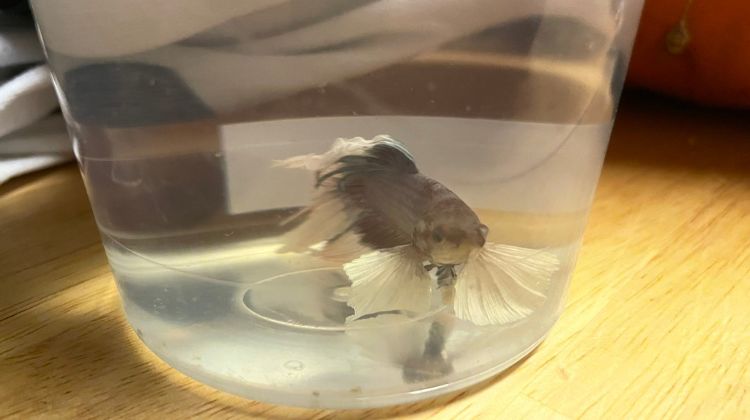Betta fish fins look ripped when the scales are so tightly packed together that they appear to have been cut. This occurs when the fish are stressed or ill. The scales can become infected and die, leaving the skin exposed.
Betta fish fins can look severely ripped or frayed. In some cases, the fins may be completely detached from the fish. This condition is known as fin rot and it is a major concern for betta fish owners.
Causes of Betta Fish Fin Rot or Ripped
Why Are Betta Fins Shredded? Here are the three most common reasons why betta fish fins may appear ragged,
Poor Water Quality
Poor water quality can cause bacterial growth that can damage fish fins. Make sure to keep your water clean by changing it regularly and adding new filter material if needed.
Lack of Oxygen
If your tank doesn’t have enough oxygenation, it will be difficult for the fish to produce their natural oils which protect their skin. Add an air stone or bubbler to help increase oxygen levels.
Bacterial Infection
Betta fish fins can often look ripped or frayed. This is usually due to fin rot, a bacterial infection that can quickly spread through a tank.
Diet
Betta fish fins can be damaged in a variety of ways, but the most common is when owners try to feed their fish pellets that are too large for their little mouths. When the pellets hit the fish’s fin, they can create tears in the fin.
If these tears become big enough, they can eventually cause the fin to tear off. In order to prevent this from happening, it is important for owners to feed their fish pellets that are the right size for their fish’s mouth.
Symptoms of Betta Fish Fin Rot
-Betta fish fins look ripped when they are displaying a disease called Finrot.
–Fins look rough, reddish-brown in color, and flaky.
-Fin rot includes slimy skin, reduced appetite, and diseased fins.
–The fins may also seem to be missing pieces or patches. If the betta fish has finnage ripped from fishing or roughhousing, then it is likely that the fish will not survive. However, some betta fish can regenerate lost fins.
How to Prevent Betta Fin Rot
If your betta fish fins are looking ragged, there are a few things you can do to help them look their best.
-First, make sure the water is clean and clear.
-Second, make sure the tank is well-lit and provides good circulation.
-Third, provide plenty of floating plants and moss to give your fish plenty of places to hide.
-Fourth, keep an eye on the temperature: betta fish like warm temperatures, but they don’t like too hot or too cold water.
-Finally, feed your fish regular meals and supplement their diet with live foods once in a while.
One of the best ways to keep your betta fish fins looking nice and sleek is to provide them with a healthy diet. Not all food items are good for betta fish, so it is important to know what foods are safe and which ones will help your finned friend stay looking sharp.
When feeding your betta during this stage, make sure that they get a balanced diet that includes both plant-based and animal-based proteins.
Some good plant-based protein sources include fresh vegetables, fruits, and whole grains. Some good animal-based protein sources include cooked chicken or fish, tofu, eggs, and cottage cheese.
During a betta fish’s fin is ripped or severely damaged, the fish may experience difficulty swimming and could eventually die. The body of a betta fish will continue to produce waste until the fish dies, so the injury may also cause an increase in watery waste accumulation. If the injury is severe enough, it may also cause pus to form and discolor the fin.
In conclusion, if you notice your betta fish fins looking ripped, it’s likely they’re in need of a good cleaning. it is most likely due to poor water quality. Make sure to keep your tank clean and full of fresh water to help keep your betta healthy.
References
- Simpson, M. J. A. “The display of the Siamese fighting fish, Betta splendens.” Animal Behaviour Monographs 1 (1968): i-73.
- Boster, James S., and Jeffrey C. Johnson. “Form or function: A comparison of expert and novice judgments of similarity among fish.” American Anthropologist 91.4 (1989): 866-889.
- Humphrey, J. D., et al. “Exotic bacterial pathogens Edwardsiella tarda and Edwardsiella ictaluri from imported ornamental fish Betta splendens and Puntius conchonius, respectively: isolation and quarantine significance.” Australian Veterinary Journal 63.11 (1986): 369-371.

I’m an aquatic veterinarian have a love for aquarium fish. The purpose of creating this blog is to share my personal experience and expertise with the most popular Betta Fish as well as other fish. If you are, interested in caring for Betta fish species just like me? Follow my articles and guides.
